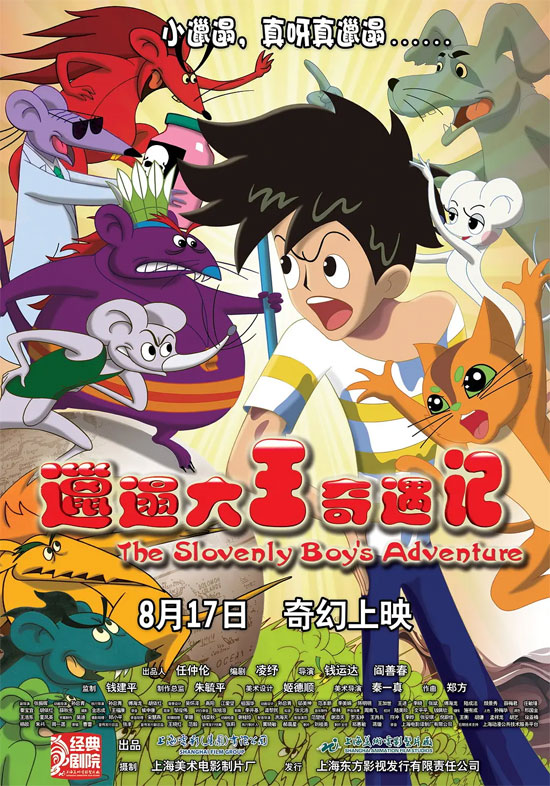Film Name: 邋遢大王奇遇记 / Slovenly Boy’s Adventure

The original “Slovenly Boy’s Adventure” was an excellent animated television series, yet the current “Slovenly Boy’s Adventure” can hardly be called a remarkable animated film. While watching the movie, we (specifically those born in the 70s and 80s) transcended not the divide between the human world and the underground kingdom of mice, but rather a span of twenty years—the gap between today’s complex lives and that irretrievable childhood.
What saddens us most is that Shanghai Animation Film Studio—once the glorious architect of Chinese animation—has now been reduced to repackaging old films, greedily sucking the last drops of life from its predecessors’ legacy while proving utterly incapable of creating new works or offering hope to future generations. Following the big-screen revivals of “The Gourd Brother,” “Inspector Black Cat,” and “The Monkey King,” “Dirty King Adventure” has finally been edited into a theatrical animated film. Is this kind of rehashing of old material truly the greatest and most celebrated creative achievement of Shanghai Animation Film Studio today?
Why is “Dirty King Adventure” an excellent television animation but not a competent theatrical animation? Because while it possesses a coherent main storyline—the Dirty King arriving in the underground mouse kingdom and seeking his way back—each 10-minute episode originally featured distinct conflicts and focal points. Some episodes highlighted the kindness of the long-tailed white mouse, others the cunning of the short-tailed white mouse, some the pretentiousness of the mouse princess, and others the dullness of the mouse scientist… Within the small-scale contexts of each TV episode, these stories function as complete units. However, when a feature film introduces a new character every few minutes—without any prior foreshadowing or setup—only for that character to swiftly fulfill their purpose and exit, the film fails to feel like an organic whole. Instead, it resembles a disjointed chronicle.
“Slovenly Boy’s Adventure” adapts the TV animation into such a disjointed film, mechanically following the original plot sequence without integrating its characters, logic, or montage editing into a cohesive whole. For instance, consider this simple alternative: what if the film opened with the Rat Kingdom developing a virus capable of annihilating all humanity, seeking human test subjects—rather than beginning with the Slovenly King? This would immediately establish the film’s central conflict. Another example: the sudden appearance of Little White Mouse feels jarring. Couldn’t the story have shown her observing this boy from the human world the moment the Slob King set foot in the underground kingdom, repeatedly hinting at her presence through shadowy silhouettes? This gradual build-up would have prepared the audience for her eventual reveal.
In short, for the Shanghai Animation Film Studio, which boasts numerous beloved characters, the issue isn’t whether to adapt them, but how to innovate in the adaptation and rewriting. The goal should be to breathe new life and youthful vitality into these classics—whether in terms of characters, plot, or narrative structure—rather than simply retelling old stories in the same old way.
As an animated film that leaves us with endless nostalgia, much like “The Gourd Brother” and “Inspector Black Cat,” “Slovenly Boy’s Adventure” possesses a unique value distinct from those two films. Its protagonist is not a stereotypical archetype but a character undergoing personal growth. The film focuses not on ideological platitudes like “good triumphs over evil,” but on how a boy who starts out messy and disheveled learns to mature, cherish friendship, and overcome his untidiness. Along the way, he inadvertently foils a conspiracy in the mouse world, completing his heroic transformation. The Slovenly Boy isn’t some distant hero—he’s just like you, me, and everyone else.
The most noteworthy character remains the kind-hearted little white mouse. Its presence introduces a nuanced shade to an otherwise black-and-white worldview. It’s surprising to find such ideological breakthroughs in 1980s animation—akin to discovering a frog soldier among the venomous creatures in The Gourd Brother. While the director’s efforts to diversify character construction are evident, this experimentation felt somewhat forced at the time. The core issue is that viewers are passively presented with the existence of this outlier mouse in a rat world steeped in theft and domination, yet the rationale behind its uniqueness remains unexplained.
Of course, viewing “Dirty King Adventure” through the lens of modern commercial animation reveals several points worthy of discussion. First, the character of the Slob King is not conducive to developing merchandise. What child would buy a Slob King doll to display at home? The educational value of this theme outweighs its commercial potential. Second, the Slob King’s story offers limited scope for further expansion. He’s called the Slob King, yet he’s already transformed from slovenly to tidy. If a sequel were made, how could the story progress? Surely they couldn’t just make him sloppy again. In other words, while the name “Slob King” is highly recognizable, it simultaneously hampers commercial expansion and limits narrative development.
When this animated film was created in the 1980s, directors didn’t contemplate such complexities. Back then, there was neither the prevailing atmosphere nor the necessity for such extensive commercial considerations. But today, for Shanghai Animation Film Studio to revive this theme in the market economy era without anticipating its marketing challenges is simply unacceptable.
Watching “Slovenly Boy’s Adventure,” the nostalgia that should have been joyful and warm ultimately pales in comparison to the heartache over Shanghai Animation Film Studio’s decline and its self-imposed stagnation. Some children, unable to follow the fast-paced, assembly-line plot, ask their mothers: “When will the movie end?” But I want to ask those at Shanghai Animation Film Studio who still call themselves “animators”: When will the end come for those who live off past glories without innovation?
Please specify:Anime Phone Cases » Slovenly Boy’s Adventure 2012 Animation Film Review: A nostalgia where sorrow outweighs joy